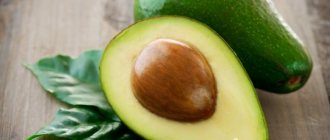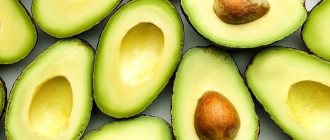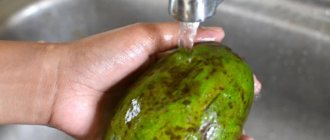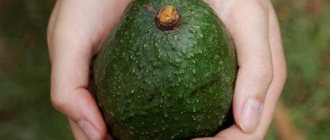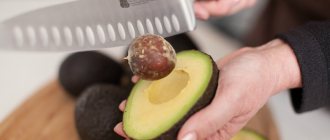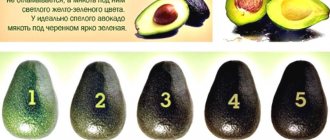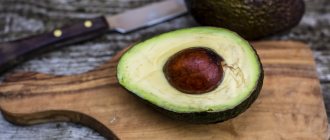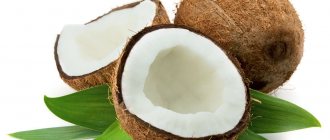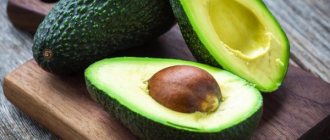Repost
There is a special pleasure when you cut into a perfect, ripe avocado, with its oily, pliable, but quite elastic flesh.
Rich in healthy fats and macronutrients, the avocado makes a delicious, energizing snack on its own and adds a wonderfully decadent, creamy flavor to dishes. But avocado is a very finicky fruit; its flesh quickly oxidizes and darkens when exposed to air. And if you only need a few slices of avocado for a salad, you are doomed to contemplate the sad fate of the remaining half of the fruit.
And although the best way to enjoy a ripe avocado is to eat it right away, there are still a few secrets to keeping your cut avocado fresh.
Don't throw away the bone
You may know that when you cut an avocado, you should use the pitted half first. Half with the pit can be stored in the refrigerator for 24 hours. Also, if you have leftover guacamole or have chopped but not used an avocado, place it and the pit in an airtight container and refrigerate. Airtight containers are better than plastic bags and film because, as the name suggests, they are airtight.
However, this method only works for short-term storage of avocados. The pit will keep the flesh underneath perfectly green since that area won't be exposed to air, but you'll still have to scrape off the brown stuff from the rest of the fruit.
Slice of lemon
Experience shows that citric acid helps preserve the color of avocados. If you want to keep a cut avocado fresh for just a few hours, say you're going to eat it for lunch at the office, place the avocado halves crosswise (just don't peel them), place a couple of lemon slices between them, squeeze tightly and wrap your “sandwich” in film.
Onion
This unexpected combination is the best way to keep avocados fresh for days. If you have leftover avocado pieces and won't be using them anytime soon, place them in an airtight container along with a large piece of onion and refrigerate. While it's not entirely clear why this odd couple works so well together, it's believed that it's due to the sulfur compounds released by onions. You don’t have to worry about the taste of avocado – it won’t change. You can also use this tip for storing guacamole.
1. Store with onions. A quarter of a freshly cut (important) onion, when placed in a plastic container with a lid with an avocado inside, will prevent the latter from darkening. The sulfur compounds released by onions are responsible for this - the same ones that often make you cry hot tears. The avocado and onion will last a couple of days together.
2. Grease with olive oil and immediately place in the refrigerator. It is necessary to lubricate generously. Essentially, you prevent air from reaching the surface and thereby prevent darkening.
3. Grease with lemon juice and also put in the refrigerator - this is if you don’t have olive oil on hand. Only if lemon is used, the avocado must also be tightly wrapped in plastic, otherwise the juice will quickly evaporate or drain.
Avocado is one of those versatile foods that can be used as an ingredient in a wide variety of dishes. However, as with other fruits, avocado tends to quickly “wither ,” that is, it quickly loses its freshness, becomes dark and, of course, no longer looks as attractive and appetizing as we would like.
Most people know that to get the most out of avocados, they are best eaten fresh and whole, and the rule of thumb is “the sooner the better.” But sometimes you can’t eat the whole avocado and you’re left with a piece that you’d hate to throw away and at the same time have nowhere to put it.
Fortunately for us, there are several ways that will allow you to keep this fruit fresh and green longer and use it for its intended purpose later.
Leave a pit
Our first tip to keep your avocado fresh longer is to leave the pit in it and don't throw it away. That is, use one half of the fruit and leave the other half along with the pit.
This is not the best way to preserve an avocado, since it only allows you to do it with one half of it (the one with the pit left).
If you have more left, the rest will quickly weather and darken. To prevent this, you can try to find something that will serve as a pit, but it is better to try to cover the entire remaining piece of avocado.
Main causes of drying out
Why do the tips of avocado leaves dry out? As a rule, the leaves dry out first . This is very dangerous for the avocado, because it can gradually die. What to do if your avocado leaves dry out? Provocateurs of dryness are low air humidity and improper watering.
To eliminate dry air, the room should be well ventilated. This is best done when the weather is humid outside. Remember to move the plant while airing. It is undesirable for him to be influenced by wind and temperature changes.
Onion
This method is as follows: you need to cut a quarter of the red onion into large pieces and place them on the bottom of an airtight container. Then you can put the half of an avocado that you have left unused there, so that the pit faces up. Close the container with a lid and place it in the refrigerator.
This tip is very effective, and the whole point is that the vapors that come from the onions allow you to preserve the natural green color and freshness of the avocado. In addition, the only part that comes into contact with the onion is the avocado peel, which means such storage will not affect its taste in any way. Yes, and chopped onions can also be used for other purposes.
Chemical composition
Avocado is the most nutritious fruit of all plant foods, with the exception of coconut. The calorie content of 1 piece of ripe fruit is 250 calories. Therefore, it is recommended to eat no more than 1/5 of an alligator pear at a time. Calorie content per 100 grams – 167 calories.
The energy ratio B: F: U is 5%: 82%: 5%.
This product is unique in composition; it contains essential unsaturated fatty acids, many vitamins, minerals, fiber, antioxidants (lutein), beta-sitosterol, which are beneficial for the human body and beauty.
Nutritional value of avocado pulp per 100 grams:
- proteins – 2 grams;
- carbohydrates – 6 grams, of which 5.3 grams are fiber, 0.7 grams are monosaccharides;
- fats – 15 grams, of which 2.4 grams are saturated lipids, 10.3 grams are monounsaturated, 2.3 grams are polyunsaturated;
- water – 73 grams.
Delicious recipe! Wine made from grapes and chokeberry together
Table No. 1 “Chemical composition of avocados”
| Name | Nutrient content in 100 grams of avocado, milligrams |
| Vitamins | |
| Retinol (A) | 0,03 |
| Thiamine (B1) | 0,06 |
| Riboflavin (B2) | 0,04 |
| Niacin (B3) | 0,6 |
| Pantothenic acid (B5) | 1,0 |
| Pyridoxine (B6) | 0,2 |
| Folic acid (B9) | 0,0185 |
| Ascorbic acid (C) | 7,7 |
| Phylloquinone (K) | 0,019 |
| Macronutrients | |
| Potassium | 280 |
| Phosphorus | 33 |
| Calcium | 15 |
| Sulfur | 15 |
| Chlorine | 11 |
| Magnesium | 10 |
| Sodium | 2 |
| Microelements | |
| Iron | 1,0 |
| Aluminum | 0,8 |
| Zinc | 0,29 |
| Copper | 0,25 |
| Manganese | 0,21 |
| Bor | 0,1 |
| Fluorine | 0,014 |
| Molybdenum | 0,01 |
| Iodine | 0,002 |
| Cobalt | 0,001 |
Avocado is a natural source of unsaturated fatty acids that are easily absorbed by the human body. Interestingly, the tropical fruit has twice the calorie content of beef, and the amount of vitamin F (omega-3.6) is three times higher than fish oil. In addition, avocado pulp contains five times more tocopherol than olive oil. It’s not for nothing that the Indians of South America call the fruit “forest oil.”
How to eat it raw?
The avocado is cut lengthwise around the pit; the skin is not peeled. After dividing the fruit into two hemispheres, take out the seed by prying it with the tip of a teaspoon. The part of the fruit planned for consumption is peeled.
Lemon juice
Another way to preserve the freshness and color of an avocado is to use lemon juice. These two ingredients complement each other perfectly and are often used together in various recipes, and therefore, despite the fact that the avocado will become more acidic, this will not spoil it at all.
Citric acid significantly slows down the oxidation process and you will just need to pour lemon juice over the rest of the avocado.
The second option is to place a large slice (circle) of lemon on top of the remaining half of the avocado (without the pit). In both cases, it is best to store avocados in an airtight container at 4 ºC for no more than 2-4 days.
Overly soft with bruised skin
When checking for ripeness, use the palm of your hand to gently squeeze the avocado. Do not press the fruit with your fingers as this may damage the flesh.
If the avocado is very hard and cannot be pressed at all, it means it is unripe. If it gives a little, it's probably ripe and ready to eat.
However, if squeezing leaves small indentations, the fruit may be too ripe to cut and would benefit from being pureed.
Delicious recipe! How to weld poses correctly
The fruit is overripe and probably spoiled, perhaps if pressure leaves large dents and the fruit becomes soft.
Also, if the avocado already has dents before you squeeze it, it's probably already started to go bad (2).
If you gently squeeze an avocado in the palm of your hand and it forms large indentations where you pressed, the fruit is overripe and likely spoiled.
Cling film
Food (polyethylene) film is also an indispensable tool for preserving the freshness of various food products and already prepared dishes. And avocado in this case will be no exception.
To do this, you just need to wrap the remaining piece of fruit in film and put it in the refrigerator. And if you notice that the avocado is still darkening (after a day or two), then it will be enough to simply remove the top weathered layer and you will again see the attractive green color of freshness.
If you hate throwing away the rest of the avocado and have nowhere to put it (everything is already cooked), then a great way to keep the fruit fresh is to make the famous and incredibly tasty guacamole from it. To do this, you just need to mash the avocado and add 1 tablespoon of lime (per half) to the resulting paste.
A tart lime juice (like lemon juice) will prevent the avocado from oxidizing and maintain its attractive green color. But to be sure, place your guacamole in an airtight container (you can also cover it with cling film first).
Thus, the film and lid will prevent the avocado from being exposed to oxygen, and hence its chapping and oxidation . Later you can use this avocado paste by adding it to a salad or just as is, it will also be very tasty.
Avocado fruits are a valuable source of protein for those following a vegetarian diet.
Some nutritionists even believe that avocado fruits can replace all other food for a person, and he can exist by eating only avocados and water. However, not every person knows how to eat avocado and what can be prepared from it.
How to peel an avocado?
To peel an avocado, you need to make a cut along the entire diameter with a sharp knife until the knife rests on the pit. Separate the two halves by twisting slightly (one clockwise and the other counterclockwise) - if the fruit is ripe, this should be very easy. Carefully walk the knife around the bone and remove it. Then you need to take half of the avocado and make another shallow cut in the skin from top to bottom. Gently pull the tip of the peel; it should peel off easily.
How to eat avocado?
The avocado fruit is eaten raw. Only the pulp of the fruit is consumed; the peel and pit are poisonous; they contain substances that can cause a dangerous allergic shock in humans.
It is easier and more convenient to eat it directly from the peel, using a spoon, sprinkling the fruit with lemon juice and seasoning with pepper and salt. When cooked, this fruit acquires a bitter taste and becomes unpalatable. You can make sandwiches from the avocado fruit, combining it with a slice of bread and a layer of fish, meat or crab sticks, and adding it to salads.
How to choose a good avocado?
To experience all the beauty of the described fruit, you need not only to know how to eat an avocado, but also how to choose it correctly.
Choose ripe fruits that are firm but not too hard. Press the peel with your finger; there should be an indentation. If the fruit is not ripe, it has a very unpleasant bitter-tart taste. Set aside those whose skin has any damage or defects and ignore the color. It can be different, because there are more than four hundred varieties of avocados in the world.
If you bought an unripe fruit, you can put it aside for a few days and it will “ripen.” The optimal temperature for long-term storage of avocados is ten degrees Celsius.
Growing an avocado from the seed?
Each fruit contains a large seed. It is not suitable for food, because... It is poisonous, but if desired, you can germinate it and plant it in the ground. If everything goes well, you will have an interesting indoor plant with a small number of leaves at the top, which, however, is very sensitive to dry air and replanting. Now plant the avocado pit with the blunt end in the ground and the sharp end should remain level with the soil. Before the leaves appear, grow the avocado at 18°C, and then transfer to a cool place.
How to eat correctly?
The vegetable fruit avocado is a universal product; it can be consumed both raw and added when preparing cold appetizers, first courses and side dishes. Thanks to its composition, it will become an indispensable component of proper nutrition and is perfect for both daily use and for the holiday table.
Before eating an avocado, you need to know how to properly peel the fruit:
- Cut the flesh in half lengthwise down to the bone.
- Separate the halves and remove the pit.
- Lift the skin with a knife and remove it by hand, or scrape the pulp from the skin using a spoon.
Raw
For exotic lovers, it will be interesting to know whether avocados can be eaten raw. Of course yes. There are a couple of simple and quick recipes for a hearty snack where the fruit is used fresh:
- The unpeeled fruit must be divided into two equal parts, remove the bone, sprinkle with lemon juice, vegetable olive oil, and sprinkle with spices. Use a spoon to eat the pulp, separating it from the skin.
- After peeling the avocado, cut into slices, pepper, salt and eat as a snack or appetizer.
- Avocado toast. Mash the peeled fruit with a fork and spread on a piece of toast or a slice of rye bread. An excellent option for a light breakfast or a healthy snack.
Knowing how to properly eat avocado raw, you can use it not only to diversify your daily menu, but also to get a sufficient amount of nutrients for the health and beauty of your body.
Avocado serving options
Cook as part of dishes
In many national cuisines of European and Asian countries, in the USA, the exotic fruit is widely used as a component of various dishes: salads, rolls, desserts, sauces, soups, and as a side dish for meat. In Russia, avocados are not so popular because not everyone knows how to properly prepare this product.
There are many simple and delicious recipes using avocados:
- Cream soup. It is necessary to beat the peeled fruit in a blender, add to the chicken broth and bring the soup to a boil. For additional taste and aroma, you can add spices, herbs, fried garlic cloves, and crackers.
- Garnish for lean meat or red fish. Avocados can be served as puree or chopped pieces of flesh, seasoned with salt, pepper and olive oil.
- Avocado in salad. It goes well with many products. The result is a tasty and healthy dish.
- Sauce. Combined with tomatoes, bell peppers, garlic and spices, the fruit will be an excellent addition to meat, fish or as a snack on toast or chips.
- Dessert. Avocado can replace butter when baking. And in some countries it is added when making ice cream and milkshakes.
Why do avocados turn dark?
Avocado flesh darkens when the fruit is cut because the enzymes in the flesh oxidize when exposed to air. This doesn't mean everything is ruined - you can just remove the top brown layer and everything will be a bunch.
That is, in other words, a blackened avocado can be eaten (if it is not spoiled, of course), it just may not look very aesthetically pleasing.
OK, let's figure out how to store avocados to preserve their freshness and appearance (if possible).
Disease Control
Avocados have enemies - small but very serious pests. First of all, powdery mildew. In fact, it is a fungus that, having penetrated the leaves, covers them with a whitish coating, very reminiscent of mold. The lower leaves take the blow first. They begin to turn yellow and then fall off. If new leaves appear, they take on a deformed shape. Soon the tree may die.
Most often, the cause of the disease lies in improper watering, when too much moisture remains, or very little. Therefore, the plant cannot be left in the open when the long rainy season has begun or the air temperature has been reduced to 15 degrees Celsius.
Plants quickly become infected with this disease from each other, therefore, if any plant shows signs of powdery mildew, it must be urgently isolated.
Experts advise to fight the disease as follows:
- Remove the leaves affected by the fungus and preferably burn them.
- Remove the top layer of soil, replacing it with a new one.
- Spray the trunk and leaves with an effective preparation. Manganese solution, mustard or soap and soda help.
After curing the plant, you need to check the condition of the foliage - the disease may return. If the plaque disappears on its own, it usually does not come back.
A couple of notes
1. When you defrost an avocado, it's best to do it slowly; you can simply move it from the freezer to the refrigerator. So, of course, the defrosting process will take longer than at room temperature, but the texture and color of the fruit will be better.
Alternatively, you can take out a bag (the one with a ziplock) and place it in a container of cold water - this is also a normal method.
2. Once frozen, the texture of the fruit will change, so it is best used for guacamole, or as a puree on bread and toast.
There is a special pleasure when you cut into a perfect, ripe avocado, with its oily, pliable, but quite elastic flesh. Rich in healthy fats and macronutrients, the avocado makes a delicious, energizing snack on its own and adds a wonderfully decadent, creamy flavor to dishes.
But avocado is a very finicky fruit; its flesh quickly oxidizes and darkens when exposed to air. And if you only need a few slices of avocado for a salad, you are doomed to contemplate the sad fate of the remaining half of the fruit.
And although the best way to enjoy a ripe avocado is to eat it right away, there are still a few secrets to keeping your cut avocado fresh.
Don't throw away the bone
You may know that when you cut an avocado, you should use the pitted half first. Half with the pit can be stored in the refrigerator for 24 hours. Also, if you have leftover guacamole or have chopped but not used an avocado, place it and the pit in an airtight container and refrigerate. Airtight containers are better than plastic bags and film because, as the name suggests, they are airtight.
However, this method only works for short-term storage of avocados. The pit will keep the flesh underneath perfectly green since that area won't be exposed to air, but you'll still have to scrape off the brown stuff from the rest of the fruit.
Slice of lemon
Experience shows that citric acid helps preserve the color of avocados. If you want to keep a cut avocado fresh for just a few hours, say you're going to eat it for lunch at the office, place the avocado halves crosswise (just don't peel them), place a couple of lemon slices between them, squeeze tightly and wrap your “sandwich” in film.
Onion
This unexpected combination is the best way to keep avocados fresh for days. If you have leftover avocado pieces and won't be using them anytime soon, place them in an airtight container along with a large piece of onion and refrigerate. While it's not entirely clear why this odd couple works so well together, it's believed that it's due to the sulfur compounds released by onions. You don’t have to worry about the taste of avocado – it won’t change. You can also use this tip for storing guacamole.
- Author: Maria Sukhorukikh
Rate this article:
- 5
- 4
- 3
- 2
- 1
(0 votes, average: 0 out of 5)
Share with your friends!
By taste or smell
Ripe avocados have a pleasant, slightly sweet aroma and a slightly nutty taste. As the fruit spoils, its taste and smell may deteriorate.
If it tastes or smells sour, it may have bacterial spoilage and should be discarded (2).
A chemical smell and taste may mean it is rancid. This can happen when oxygen or microbes damage or break down the unsaturated fat in the fetus (4).
Rancidity can lead to the formation of potentially toxic compounds. Don't eat an avocado if you think it's rancid (5).
The taste of spoiled avocados can vary, but it's usually easy to tell if they've gone bad based on the taste.
You can tell if an avocado has gone bad by smell, taste, touch, and visual inspection.
A sour taste or smell, as well as a rancid aroma and chemical taste mean the avocado is spoiled and you should discard it.
